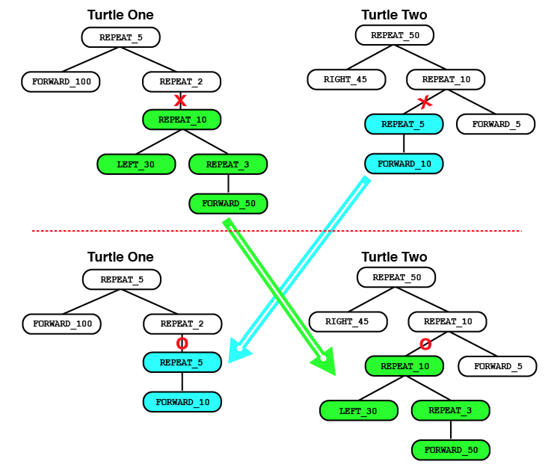
The heart of Evolved Art's evolution, and evolution in general, is known as crossover. When combined with fitness selection, otherwise known as survival of the fittest evolution becomes a powerful force of nature. Darwin's discovery of this simple concept continues to fascinate scientists to this day, and has provided Evolved Art with a powerful mechanism for evolving beautiful drawings.
On the Turtle Programming Language page the programming language used in Evolved Art was described. Expression trees were also introduced. It is expression trees that Evolved Art uses to evolved the turtles. This evolution is performed by using crossover to exchange genetic material (programs) between turtles when evolving the next generation. When you evolve a turtle population, turtle pairs are selected and their genetic material is crossed to produce offspring. The offspring fill the next generation's population.
There are two steps involved in evolving a population, selection and crossover. First, two turtles must be selected for crossover, then their genetic material (their programs) will be crossed over to produce their offspring. Turtles are selected using fitness-based random selection - the selection is random, but turtles that are more fit are more likely to be selected. The fitness is determined by the fitness function, which is calculated using the fitness parameters that you set when you create the population, as well as the Like / Not Like quality. When you Like a turtle, its fitness calculation is left unchanged, but when you Not Like a turtle, its fitness is reduced to almost zero, making the probability of it being selected for reproduction very unlikely.
Once two turtles are selected to reproduce, crossover will occur. The following figure illustrates what occurs during crossover. The top of the drawing shows two turtles, Turtle One and Turtle Two, which were selected for crossover. Once the turtles are selected, their expression tree is analyzed and metered. Then a random location in the expression tree is chosen for the crossover to occur. In the figure, these locations are shown with a red cross. Once the crossover locations are determined for each turtle's expression tree, the trees are broken apart and the pieces are recombined as they are crossed over. In the figure, the colored portions of the trees are shown with matching colored arrows to show the process. In the lower half of the figure, you can see the offspring's expression trees and the result of the crossover. The red circles show the locations where the trees were recombined.
